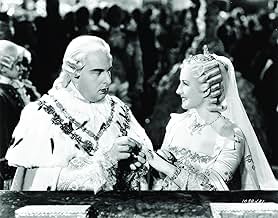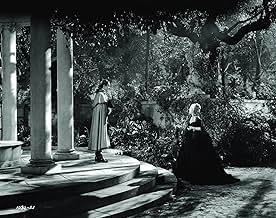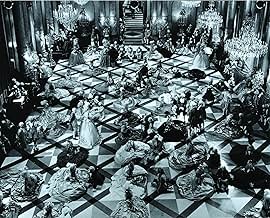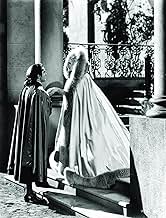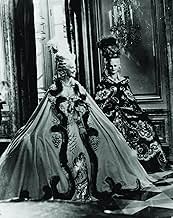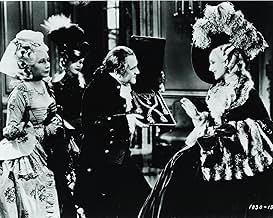AVALIAÇÃO DA IMDb
7,3/10
3,4 mil
SUA AVALIAÇÃO
Adicionar um enredo no seu idiomaThe tragic life of Marie Antoinette, who became queen of France in her late teens.The tragic life of Marie Antoinette, who became queen of France in her late teens.The tragic life of Marie Antoinette, who became queen of France in her late teens.
- Direção
- Roteiristas
- Artistas
- Indicado a 4 Oscars
- 5 vitórias e 5 indicações no total
Albert Dekker
- Comte de Provence
- (as Albert Van Dekker)
Avaliações em destaque
10benoit-3
10. The script
Uncredited as a scriptwriter is novelist F. Scott Fitzgerald. His love scenes are extremely elaborate and exquisitely structured. They also introduce innovations that have since become clichés and the hallmark of 'women pictures' everywhere.
9. The actors
Barrymore is unforgettable as the regally cranky Louis XV. Morley gives one of his best interpretations. Schildkraut plays the best two-faced villain of his entire body of work. As for Power... remember the anecdote about the reporter asking romance-writer Barbara Cartland (Lady Di's stepmother) how she could possibly have written so many romance novels before she was even married and while she was still a virgin? Her answer was: 'Oh! We didn't have sex in those days. We had Tyrone Power.'
8. The director
Van Dyke was an expert at handling large crowds and acts of God. His directing style was a compromise between time-efficiency and giving the stars leeway as long as they respected the general style of the piece. This 'honour system' seems to have encouraged the actors to do their homework and present a credible, coherent performance every time. He also got an assist here from uncredited French genius Julien Duvivier.
7. Artistic direction
What can you say about a period film that tackled the challenge of recreating Versailles in the XVIIIth century on the MGM back lot? The production values are staggering. The Gallery of Mirrors is actually longer, higher and wider than the original. The costumes tread a fine line between historical accuracy (covered shoulders and revealed cleavage) and the requirements of the movie code (exposed shoulders were tolerated but bosoms had to be covered) but still manage to convey the era and the fairy-tale quality of Marie's court. The costumes were also specially constructed to shine, glitter and shimmer on black and white film.
6. Historical accuracy
The film's script is based (in part) on Stefan Zweig's groundbreaking biography of the Queen, "Marie Antoinette, Portrait of an Ordinary Woman", which tried to create the first accurate, adult, factual but Freudian-inspired narrative of the Queen's life by using documents and correspondence that had long been overlooked or suppressed. The book was the first to reveal Louis XVI's mechanical sexual problems, which prevented his consummating the marriage during its first seven years (until a slight surgical intervention) and explained in turn the Queen's extravagant spendthrift personality, in Freudian terms, as extreme sexual frustration. This story actually makes it to the screen in a large degree. Compare this to recent biopics like "A Beautiful Mind", whose scriptwriters conveniently 'forget' essential but non-mainstream plot elements like the fact that John Nash's paranoia may have been caused or amplified by the McCarthy era persecution of homosexuals. Some historical events have been telescoped into one another in order to accommodate the general American public's limited understanding of French history and the Orléans character was used to maintain tension by representing the turncoat part of the nobility which exploited MA for their own various agendas.
5. The music
Herbert Stothart may not be a household word but he did win an Oscar for his original score to "The Wizard of Oz", based, of course in part on Harold Arlen's melodies. Besides giving Miss Gulch/the Wicked Witch her immortal theme, he is also one half of the composing team that produced the operetta "Rose Marie". Stothart shines in two respects: the approximate recreation of XVIIIth century dance music in the court scenes, emphasizing the bored grandeur of the proceedings, and the psychological music that accompanies everything from exciting chase scenes to the love scenes between Shearer and Tyrone. Note especially the use of the harpsichord in a rupture scene between Orléans and MA and the use of the viola d'amour in the garden love scene.
4. The cinematography
MA is in 'glorious black and white', but especially in the escape to Varennes sequence which has the most credible - and suspenseful - 'day for night' sequence ever filmed. The marriage scene may have inspired Queen Elizabeth II's coronation. Also notable are the matte paintings, the overwhelming use of cranes to move in on particular characters in a crowd scene and the chiaroscuro of the last meeting with Fersen.
3. Detail and scope
Every scene has something special added to it in characterization, movement, rhythm, lighting, art direction, choreography (and not just in the dance scenes). The costumes could have starred in a picture by themselves.
2. The lost art of story-telling
This film was planned with intelligence and skill and was built around the principle stated by Selznick when filming GWTW: 'The secret of adapting a book to the screen is to give the impression that you are adapting a book to the screen.' Which means that many literary devices are used to give the story many interesting arcs and recurring themes. The story is well balanced in terms of spectacular action, recreation of important historical events (giving the impression of the passage of time) and intimate scenes. It is truly 'the intimate epic' that Mankiewicz's 'Cleopatra' was supposed to be. Need I add I am really dreading the Sofia Coppola version...
1. Norma Shearer
Norma Shearer is an unjustly forgotten star of the first magnitude. MA is permanent testament to her uncanny abilities. In this film she portrays the main character from the age of sixteen to her death as a prematurely aged and debilitated woman of 38, all with perfect verisimilitude, thanks to her magnificent vocal instrument and stage presence. As a fairy-queen, she makes Cate Blanchett as Galadriel (in LOTR) look like Carol Burnett's charwoman. Her virtuosity as the fated widowed Queen is all the more poignant when one realizes that at the time she was Thalberg's widow in her last husband-approved venture and that the Hollywood suits were rapidly closing in on her.
Uncredited as a scriptwriter is novelist F. Scott Fitzgerald. His love scenes are extremely elaborate and exquisitely structured. They also introduce innovations that have since become clichés and the hallmark of 'women pictures' everywhere.
9. The actors
Barrymore is unforgettable as the regally cranky Louis XV. Morley gives one of his best interpretations. Schildkraut plays the best two-faced villain of his entire body of work. As for Power... remember the anecdote about the reporter asking romance-writer Barbara Cartland (Lady Di's stepmother) how she could possibly have written so many romance novels before she was even married and while she was still a virgin? Her answer was: 'Oh! We didn't have sex in those days. We had Tyrone Power.'
8. The director
Van Dyke was an expert at handling large crowds and acts of God. His directing style was a compromise between time-efficiency and giving the stars leeway as long as they respected the general style of the piece. This 'honour system' seems to have encouraged the actors to do their homework and present a credible, coherent performance every time. He also got an assist here from uncredited French genius Julien Duvivier.
7. Artistic direction
What can you say about a period film that tackled the challenge of recreating Versailles in the XVIIIth century on the MGM back lot? The production values are staggering. The Gallery of Mirrors is actually longer, higher and wider than the original. The costumes tread a fine line between historical accuracy (covered shoulders and revealed cleavage) and the requirements of the movie code (exposed shoulders were tolerated but bosoms had to be covered) but still manage to convey the era and the fairy-tale quality of Marie's court. The costumes were also specially constructed to shine, glitter and shimmer on black and white film.
6. Historical accuracy
The film's script is based (in part) on Stefan Zweig's groundbreaking biography of the Queen, "Marie Antoinette, Portrait of an Ordinary Woman", which tried to create the first accurate, adult, factual but Freudian-inspired narrative of the Queen's life by using documents and correspondence that had long been overlooked or suppressed. The book was the first to reveal Louis XVI's mechanical sexual problems, which prevented his consummating the marriage during its first seven years (until a slight surgical intervention) and explained in turn the Queen's extravagant spendthrift personality, in Freudian terms, as extreme sexual frustration. This story actually makes it to the screen in a large degree. Compare this to recent biopics like "A Beautiful Mind", whose scriptwriters conveniently 'forget' essential but non-mainstream plot elements like the fact that John Nash's paranoia may have been caused or amplified by the McCarthy era persecution of homosexuals. Some historical events have been telescoped into one another in order to accommodate the general American public's limited understanding of French history and the Orléans character was used to maintain tension by representing the turncoat part of the nobility which exploited MA for their own various agendas.
5. The music
Herbert Stothart may not be a household word but he did win an Oscar for his original score to "The Wizard of Oz", based, of course in part on Harold Arlen's melodies. Besides giving Miss Gulch/the Wicked Witch her immortal theme, he is also one half of the composing team that produced the operetta "Rose Marie". Stothart shines in two respects: the approximate recreation of XVIIIth century dance music in the court scenes, emphasizing the bored grandeur of the proceedings, and the psychological music that accompanies everything from exciting chase scenes to the love scenes between Shearer and Tyrone. Note especially the use of the harpsichord in a rupture scene between Orléans and MA and the use of the viola d'amour in the garden love scene.
4. The cinematography
MA is in 'glorious black and white', but especially in the escape to Varennes sequence which has the most credible - and suspenseful - 'day for night' sequence ever filmed. The marriage scene may have inspired Queen Elizabeth II's coronation. Also notable are the matte paintings, the overwhelming use of cranes to move in on particular characters in a crowd scene and the chiaroscuro of the last meeting with Fersen.
3. Detail and scope
Every scene has something special added to it in characterization, movement, rhythm, lighting, art direction, choreography (and not just in the dance scenes). The costumes could have starred in a picture by themselves.
2. The lost art of story-telling
This film was planned with intelligence and skill and was built around the principle stated by Selznick when filming GWTW: 'The secret of adapting a book to the screen is to give the impression that you are adapting a book to the screen.' Which means that many literary devices are used to give the story many interesting arcs and recurring themes. The story is well balanced in terms of spectacular action, recreation of important historical events (giving the impression of the passage of time) and intimate scenes. It is truly 'the intimate epic' that Mankiewicz's 'Cleopatra' was supposed to be. Need I add I am really dreading the Sofia Coppola version...
1. Norma Shearer
Norma Shearer is an unjustly forgotten star of the first magnitude. MA is permanent testament to her uncanny abilities. In this film she portrays the main character from the age of sixteen to her death as a prematurely aged and debilitated woman of 38, all with perfect verisimilitude, thanks to her magnificent vocal instrument and stage presence. As a fairy-queen, she makes Cate Blanchett as Galadriel (in LOTR) look like Carol Burnett's charwoman. Her virtuosity as the fated widowed Queen is all the more poignant when one realizes that at the time she was Thalberg's widow in her last husband-approved venture and that the Hollywood suits were rapidly closing in on her.
This is a fantastic movie, a real emotional roller coaster, one feels emotionally exhausted at the end, the last 20mins are truly harrowing. How Norma Shearer didn't win the academy award for best actress is beyond me. Other great performances include the debut of Robert Morley and the incredible acting of Joseph Schildkraut, the makeup he wears must have been truely scandalous at the time. The costumes are spectacular you really are taken back to the late 1770's. another point of note is how Norma Shearer ages in the film is incredible, from the young girl in the beginning to the much older broken woman at the end, very well done indeed. Tyrone Power is very good as well, one can go on for ages about Marie Antoinette, it truly is a spectacle in the grand MGM scale. 8 1/2 out of 10!
As a young actress still in her 20s, Norma Shearer was hailed as the First Lady of MGM, and she reigned as queen of the studio throughout the 1930s. For about two decades after early retiring in 1942, she was fondly remembered by fans and critics, but slowly she was mostly forgotten. Then in the early 70s, antagonistic film critic Pauline Kael, grudge-holding MGM rival Joan Crawford and others took delight in trashing her, usually with the implication that Norma's greatest talent was finding a powerful husband (Irving Thalberg). Unfortunately, those unfair remarks carried great weight since Shearer's movies were unavailable on video and rarely shown on TV.
We're now able to see her talent for ourselves, thanks largely to Turner Classic Movies, and Norma Shearer's star is rising again.
If you've never seen a Shearer movie, Marie Antoinette is a good beginning. It is one of Hollywood's great epics of the 1930s, with lavish costumes and scenery, and its historic setting holds up well. Shearer plays the doomed French queen from teenager to the Guillotine, and the final scenes as she awaits death in prison are among the finest of her career.
In recent years, Shearer has gained new respect for her silent and pre-code films, in which she was one of the most accomplished young actresses of the era. She often played sexually sophisticated women with a sly wit. She was not a typical ingénue, and you can see why audiences of the time were enchanted by her.
We're now able to see her talent for ourselves, thanks largely to Turner Classic Movies, and Norma Shearer's star is rising again.
If you've never seen a Shearer movie, Marie Antoinette is a good beginning. It is one of Hollywood's great epics of the 1930s, with lavish costumes and scenery, and its historic setting holds up well. Shearer plays the doomed French queen from teenager to the Guillotine, and the final scenes as she awaits death in prison are among the finest of her career.
In recent years, Shearer has gained new respect for her silent and pre-code films, in which she was one of the most accomplished young actresses of the era. She often played sexually sophisticated women with a sly wit. She was not a typical ingénue, and you can see why audiences of the time were enchanted by her.
It never ceases to amaze me at how completely I might be suddenly drawn into the emotional moment of a film by the power of the actor. Usually the strongest ones come suddenly, and without warning, giving you no time to put up defenses. Brando's eruptions of moods when talking to his dead wife in Last Tango in Paris is probably the most dramatic example of this. (His greatest scene ever, that I have witnessed) But before that, Norma Shearer's panic and utter emotional breakdown when the guards come to take her son from her in the prison, is overwhelming and complete. Anyone who is not genuinely moved to the core by this incredible performance, either sleeps or does not possess those human sensitivities that are torn by the loss of a child. For it is not sympathy that is evoked, but an empathy called forth by the raw, human agony of the suffering before you. Years later when I visited the actual site in Paris where that tragedy would have taken place, I experienced a time of respect and reflection such as I have never had in any other place in the world that I have visited.
This is one of the truly great films. If you want to find out how deeply someone can feel, show it to them and observe. Norma Shearer set a standard I fear has been forgotten, as evidenced by the way tinsel town hands out awards today for mediocre work pushed onto the modern consciousness by glitzy ad campaigns and self-serving accolades.
This is one of the truly great films. If you want to find out how deeply someone can feel, show it to them and observe. Norma Shearer set a standard I fear has been forgotten, as evidenced by the way tinsel town hands out awards today for mediocre work pushed onto the modern consciousness by glitzy ad campaigns and self-serving accolades.
This movie will probably never be excelled largely because of the casting. I don't believe that anyone will ever find better actors or actresses to portray King Louis XVI and Queen Marie Antoinette than Robert Morley and Norma Shearer. The black and white aspect of this great classic film is simply spell binding in its interpretation of the life of the Royal Family. Color will give it a different dimension. The manner in which the conflict of the ensuing mob marching upon the Versailles is well portrayed. I especially like the sense of paranoia and fear that grip the Queen and her entourage. The use of the outside gate is especially endearing to me, reminding me why it is that King Louis XIV created the Château d' Versailles in such a distance from Paris. Unless one knows the history of the Château, nobody can truly appreciate the march of the Faubourgs. Excellent film, and I recommend seeing it before any other on the same subject!
Você sabia?
- CuriosidadesAccording to Wikipedia, the movie had thousands of costumes and lavish set designs. Adrian visited France and Austria in 1937 researching the period. He studied the paintings of Marie Antoinette, even using a microscope on them so that the embroidery and fabric could be identical. Fabrics were specially woven and embroidered with stitches sometimes too fine to be seen with the naked eye. The attention to detail was extreme, from the framework to hair. Some gowns became extremely heavy due to the embroidery, flounces and precious stones used. Norma Shearer's gowns alone had a combined weight of over 1,768 lb., the heaviest being the wedding dress.
- Erros de gravaçãoAt the time of their wedding, the Dauphin, Louis, was 15 and Marie Antoinette was 14. Norma Shearer could (barely) get away with portraying a 14-year-old (as she portrayed a 13-year-old Juliet in ROMEO AND JULIET (1936) because many noble/royal females were more mature and had regal bearing), but Robert Morley looked 35, not 15.
- Citações
Marie Antoinette: I once thought if I were queen, I'd be so happy. To be applauded and adored and obeyed. I don't want it now. I just want to be free. To be with you. To love you. I cannot wear a crown upon my heart.
- Versões alternativas"Unrestored" film has now been restored and is available on DVD. When the film played the Carthay Circle in Los Angeles and the Astor Theatre in New York as a reserved seat "road show" attraction, the print ran eleven minutes longer than the generally available 149 minute Turner Library print. These eleven minutes contained an overture, entr'acte, and exit music, with an intermission immediately following Antoinette's emotional farewell to Fersen on the steps of Versailles. These remnants of the "road show" presentation have now been restored to the new Warner Bros. Home Video DVD, which runs a little over 157 minutes.
- ConexõesEdited into Hollywood: The Dream Factory (1972)
Principais escolhas
Faça login para avaliar e ver a lista de recomendações personalizadas
- How long is Marie Antoinette?Fornecido pela Alexa
Detalhes
- Data de lançamento
- País de origem
- Idioma
- Também conhecido como
- Marie Antoinette
- Locações de filme
- Chateau de Versailles, Versailles, Yvelines, França(palace backgrounds)
- Empresa de produção
- Consulte mais créditos da empresa na IMDbPro
Bilheteria
- Orçamento
- US$ 2.926.000 (estimativa)
- Tempo de duração2 horas 29 minutos
- Proporção
- 1.37 : 1
Contribua para esta página
Sugerir uma alteração ou adicionar conteúdo ausente



